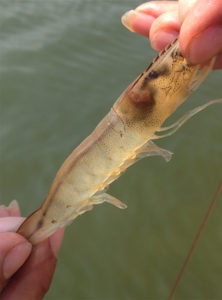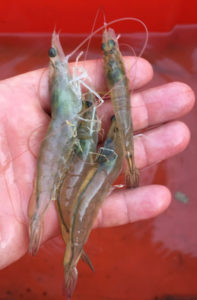A better understanding of enzyme supplementation in aquafeeds is essential

Digestion, a complex physiological process, depends on molecular activation and recognition and hydrolysis of food in specific conditions. The process involves digestive enzymes for breaking down polymeric macromolecules into smaller building blocks facilitating nutrient absorption.
In crustaceans, life stage, age, molting stage, circadian cycle, feed composition and environmental conditions all affect digestive enzyme production. Among these enzymes, proteases are the most important ones responsible for hydrolyzing dietary proteins and breaking them into smaller peptides and free amino acids. The protease activities in the digestive tract of an animal are induced by feeding, and are usually affected by genetic features of the individual, age, life stage and the culture environment.
Effect of environment and diet on digestive enzymes

Environment, diets and their interactions appeared to affect the enzyme production in all animals. The species-specific differences in the optimum pH and temperature range of proteolytic enzymes of aquatic animals can be attributable to their habitat, food and genotypic and phenotypic differences. For example, the optimum pH range in crustaceans usually ranges between 7.0 and 8.0 for trypsin-like enzymes, and for chymotrypsin-like enzymes, from 7.5-8.0 for the São Paulo shrimp (Farfantepenaeus paulensis). Whereas, in the marine, edible crab (Cancer pagurus) it ranges from 8.0 to 10.0.
Differences in proteolytic activity can be significant for shrimp reared in culture environments with large variations in quantity and quality of natural food. For example, Moss et al. (2001) reported significantly higher activity of serine protease (71648-unit vs 30200-unit/mg soluble protein), collagenase (653-unit vs 312-unit/mg soluble protein), and acid phosphatase (189-unit vs 83-unit/mg soluble protein) in Pacific white shrimp cultured in pond water than those in well water. Higher enzymatic activity in shrimps in pond water indicates the presence of natural food in the system. Interestingly, among digestive enzymes, only the chitinase activity was higher in shrimp reared in clean water, indicating that the animals were feeding on molted shells, high in chitin.
Dietary protease, a solution in hand
High cost and limited availability of fishmeal and other balanced protein sources are frequently forcing aquafeed manufacturers in many regions to rely on low-cost but poorly digestible alternatives. At the same time, there is increasing pressure to lower environmental and economic costs, putting a serious onus on feed manufacturers to improve nutrient digestibility of aquafeeds while lowering the manufacturing cost.
Better nutrient digestibility
Davis et al. (1998) tested the apparent digestiblity of dry matter (ADCDM) and crude protein (ADCCP) in Pacific white shrimp (Litopenaeus vannamei) fed diets supplemented with graded levels (0, 0.2 or 0.4 percent) of a protease, an reported that the ADC of CP (74.3 percent) in shrimp fed 0.4 percent protease diets was higher than for those animals fed the control (65.3 percent) or other diets. In a subsequent trial, these authors reported poor growth performance (weight gain, feed efficiency, and protein efficiency ratio) in shrimp fed diets with the protease.
Better performance and immmune response
Recently, Li et al. (2015) reported significant increases in weight gain (288 percent) and feed conversion (1.29) for Pacific white shrimp fed low-fishmeal diets (38 percent CP, 22 percent fishmeal) supplemented with 175 mg/kg of a commercial multi-component protease (Jefo Nutrition Inc., Canada) compared to those animals fed the same diet without the supplementation (275 percent and 1.42, respectively). The authors suggested the possible use of protease in aquafeed to reduce or replace expensive protein sources with poorly digestible and less-expensive ingredients without affecting the performance of the cultured animals (Table 1).
Chowdhury, Table 1
| Parameters | Positive control (PC) 40% CP, 25% FM | Negative control (NC) 38% CP, 22.5% FM | NC + 175 mg/kg protease 38% CP, 22.5% FM |
|---|---|---|---|
| FBW, g | 12.9 +/- 0.6b | 11.5 +/- 0.5a | 12.4 +/- 0.2b |
| FCR | 1.14 +/- 0.05a | 1.28 +/- 0.05b | 1.16 +/- 0.04a |
| HP_PROT, U/g tissue | 3665 +/- 203b | 3257 +/- 192a | 3788 +/- 167b |
| IN_PROT, U/g tissue | 520 +/- 57b | 499 +/- 30a | 527 +/- 37b |
Song et al. (2016) also reported significantly better weight gain and FCR in shrimp fed low-fishmeal (LFM, 10 percent) diets supplemented with the protease, compared to the same diet without supplementation. They also reported significantly higher serum phenol oxidase concentration and lower malondealdehyde concentration in both serum and hepatopancreas in shrimp fed the protease supplemented diets. The authors also conducted a disease challenge test with a pathogenic strain of Vibrio parahaemolyticus and reported a linear decrease in 96 hours cumulative mortality of shrimp fed diets with 0, 125, 150 and 175 ppm of the protease (Table 2).
Chowdhury, Table 2
| Parameters | Positive control (PC) 20% FM | Negative control (NC) 10% FM | NC + 125 mg/kg protease | NC + 150 mg/kg protease | NC + 175 mg/kg protease |
|---|---|---|---|---|---|
| FBW, g | 12.3 +/- 0.3d | 11.0 +/- 0.3a | 11.3 +/- 0.3ab | 11.7 +/- 0.5bc | 12.0 +/- 0.5cd |
| Trypsin, U mg-1 PROT | 4927 +/- 21e | 2106 +/- 59a | 3419 +/- 192b | 4048 +/- 137c | 4576 +/- 141d |
| PO_S, U mL-1 | 672 +/- 11bc | 525 +/- 14a | 605 +/- 55b | 691 +/- 4c | 890 +/- 63d |
| MDA_S, nmol/mL | 12 +/- 1.1b | 16 +/- 0.2d | 14 +/- 0.1d | 13 +/- 0.6c | 9 +/- 0.2a |
| PO_HP, U/mL | 1028 +/- 13c | 701 +/- 30a | 739 +/- 52a | 833 +/- 11b | 1032 +/- 35c |
| CMR_96h | 0.31 +/- 0.09a | 0.54 +/- 0.04b | 0.46 +/- 0.05b | 0.40 +/- 0.04ab | 0.32 +/- 0.06a |
Perspectives
Ingredients, diets, age, size, molting stage and culture environment (such as pH, temperature and dissolved oxygen levels) can significantly affect digestive enzyme production in crustaceans and other animals. The complex nature of diet and environment, and their effects on digestive enzyme production, requires a better understanding of these enzymes. There are about 14 different types of digestive proteolytic enzymes reported in shrimp, with varying degrees of temperature and pH optima. The composition of these enzymes and their interaction with environment and diets can significantly influence the digestive capacity and immune response of the shrimp.

Dietary enzymes are a major alternative to improve feed quality and for better nutrient digestibility, and also to reduce organic wastes. Additionally, enzyme supplementation can improve gut health, compensate digestive enzymes when needed, and may also improve immune responses.
However, a large majority of the stakeholders remains skeptical because of issues with heat stability, interactions with other enzymes, safety of recommended dosages and insufficient knowledge on suitable substrates for enzymes. Our lack of understanding on suitable substrates often leads to unnecessary or improper use of some enzymes under various brands of multi-enzyme complexes, where proteases, carbohydrases, phytase – and sometime even lipases – are combined.
It is important to understand that each specific enzyme usually attacks specific active sites in a complex molecule. For example, an enzyme containing a single protease enzyme may be only suitable for specific substrates or ingredients. On the other hand, an enzyme containing multiple protease activities can be suitable for multiple substrates and can react positively with a wide range of raw materials. With the omnipresence crisis for quality raw materials, an industry-wide understanding of dietary enzyme application is essential, not only for shrimp aquafeeds but also for aquafeeds in general.
Further research is needed to understand the effects of different dietary proteases on the quality of proteins in feed, their interactions with various ingredients, gut health and nutrient utilization. The appropriate application of the dietary proteases available in the market has also been an issue because of the heat stability concerns and fear of destruction during manufacturing. Some better heat-stable enzymes are available in dry powder form, can be readily added to the mixer during aquafeed manufacturing, and can keep most of their activity intact. Other enzymes are either coated or available in liquid form for post-pelleting application requiring costly mechanical tools.
We also need a better understanding of the advantages and disadvantages of the various application methods when selecting an enzyme. The ability to apply enzymes directly to the mixer may have several advantages. In addition to the ease of handling, the protease may also alter the quality of feed proteins during cooking or conditioning, resulting in better quality aquafeeds. And a partial coating could provide a better solution to improve heat stability.
As the cost and availability of quality protein sources are increasingly becoming an issue, the use of dietary proteases could provide a better solution to the sustainability of the aquaculture industry. However, we are still in the infancy of our understanding of the complexity of the protease world. A renewed and targeted focus in our research agenda is, therefore, strongly recommended to fully utilize the potential of protease enzymes.
All references available from author.
Now that you've finished reading the article ...
… we hope you’ll consider supporting our mission to document the evolution of the global aquaculture industry and share our vast network of contributors’ expansive knowledge every week.
By becoming a Global Seafood Alliance member, you’re ensuring that all of the pre-competitive work we do through member benefits, resources and events can continue. Individual membership costs just $50 a year. GSA individual and corporate members receive complimentary access to a series of GOAL virtual events beginning in April. Join now.
Not a GSA member? Join us.
Author
Tagged With
Related Posts

Health & Welfare
Dietary acidification in aquaculture
Much of the chemical breakdown of foodstuffs begins in the stomachs of animals through acidification. Effective use of digestive biology is a goal in aquaculture, so dietary acidifiers have been gaining interest in recent years.

Aquafeeds
New bio-processed protein concentrate shows potential
The performance of a new fishmeal replacement product was assessed for Pacific whiteleg shrimp juveniles using various experimental diets. Results indicate that this plant-based, fishmeal replacement product could be used to replace significant levels of fishmeal in shrimp aquafeed diets.

Aquafeeds
Shrimp feeds depend on proper ingredient grinding
The proper feed particle sizes of aquafeed ingredients are established by the nutritional requirements of the species targeted and by the feed manufacturing process used. For proper ingredient particle sizes, various characteristics are very important, including particle size distribution and pellet density.

Aquafeeds
The importance of carotenoids in aquafeeds
Carotenoids are important pigments that contribute characteristic quality criteria for the marketing of aquaculture products. Aquatic animals cannot biosynthesize carotenoids de novo, hence their inclusion in aquafeeds is important because they are associated with various metabolic functions.


